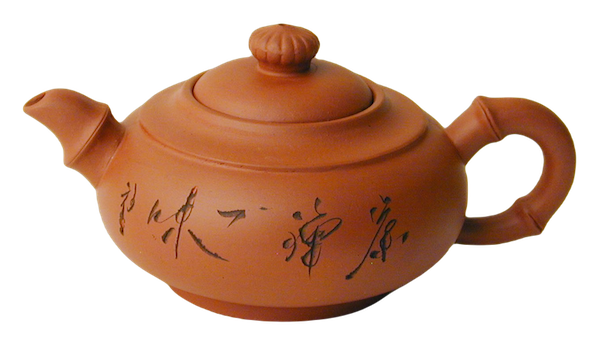Cheap Eats:
Cha Yeh Tan
Chinese Tea Eggs
Eggs seem pretty simple—a real timesaving item that can be whipped up in no time. Sure, there are dishes that feature eggs that can be complicated and time-consuming, but how long can it take to make a simple egg?
Well, if you ask the Chinese, the answer can be hours, days, even months.

I have no doubt that the so-called 1,000-year-old-egg was “invented” by accident, but one wonders how hungry you’d have to be to try the first one. Actually, these eggs are generally only three or four months old, but I’m not sure an extra hundred years would make much of a difference. Of course, that was the point. These eggs, also called preserved eggs or 100-year-old eggs, were designed to be eaten when fresh eggs were not available. Eggs, traditionally duck eggs, are wrapped in a complex mixture of garden lime, salt, wood ash (from charcoal plus several different woods, including pine), earth, and tea. This mixture is packed around the eggs, which are then wrapped in rice husks and buried or put in an airtight container and set aside for three to four months.
A complex set of chemical reactions render the egg white a solid—about the consistency of a hard-cooked egg, but a little softer. The white turns dark brown and clear, sort of like Coke JELL-O® in appearance (though others with fonder associations with this dish have compared it to black opal or dark amber). The yolk turns rather green. There is a faint smell of ammonia, but once you get past that (and it’s not that bad), the egg is not unpleasant. It has a kind of creamy texture, but otherwise tastes remarkably egg-like. You can eat them straight, or cut them in wedges and serve them with sweet pickled vegetables or a sauce of vinegar, soy sauce, rice wine, and minced ginger.

But don’t worry. I’m not going to give you a recipe for 1,000-year-old-eggs.
They’re just an example of one way to take a really long time to prepare something we think of in terms of minutes. Instead, I’m going to give you a recipe for Chinese tea eggs. These only take about 12 hours to prepare, as opposed to four months, and you get to skip the dirt and ashes. (And don’t worry—for most of the 12 hours, the eggs just sit, so this isn’t as time-consuming as it sounds.)
Chinese tea eggs are usually served as appetizers, but can also be served as snacks or as part of a cold plate, along with salads and cold meats. They look fabulous, with a wonderfully marbled appearance that makes them fun to serve. However, they are not just lovely to look at; they have a delightful, subtle, exotic flavor that is most enjoyable. And surprisingly, after all the hours of cooking, the texture is not much different from that of a regular hard-cooked egg. Enjoy.
Cha Yeh Tan
(Chinese Tea Eggs)
12 eggs
2 scant Tbs. salt
4 Tbs. soy sauce
2 whole star anise (or 16 sections, if stars are broken)
4 tsp. black tea leaves
Place the eggs in a pot or saucepan and cover with cold water. Bring to a boil, then reduce heat and simmer for 20 minutes. Remove pot from heat and let sit for five minutes. Then pour off the water, and run the eggs under cold water for a minute, to make them easier to handle.
Using the back of a spoon, crack the eggs all over until the shells have a network of fine cracks. (But don’t roll the eggs on a surface or otherwise create crushed, rather than cracked, shells.) Now return the eggs to the pot in which you cooked them. Add water to cover, then add the salt, soy sauce, star anise, and tea. Bring to a boil over high heat, then reduce the heat to low, cover, and simmer the eggs for 2 to 3 hours. (Check after an hour or so to make sure the eggs are still covered with liquid. Add boiling water if necessary.)
Turn off the heat and leave the eggs, still covered by the liquid, at room temperature for at least 8 hours or overnight. At the end of this time, you can remove the eggs from the liquid and store them in the fridge for up to a week.
When you are ready to serve the eggs, carefully remove the shells and arrange your beautifully marbled eggs on a platter. Cut some into quarters or halves, for ease of serving, but you’ll probably want to leave most of them whole, so people can admire the patterns.
Notes:
Star anise can be obtained at many Asian grocery stores, especially those that feature Chinese ingredients. However, at my go-to place for Chinese goodies, Tianlai on Dundee Rd., they’re kept with the dried foods (dried mushrooms and such), rather than with the spices— so you may need to hunt a bit. Otherwise, just check with The Spice House or Penzeys. They have everything.
When choosing a pan for making this recipe, try for something where the eggs can all be in one layer, but without too much space around them. The more water you have to add to cover the eggs, the more diluted the mixture becomes, so you don’t want the eggs far apart in a huge pan.
If you don’t have loose tea, four teabags will work.
The reason you don’t want to break the shells too much is that they start to fall apart while simmering, and then you don’t get the marble effect—just a solid brown egg, and a salty one at that.
Make sure the eggs are covered by the liquid when they sit at room temperature, as this actually protects the eggs from spoilage. If air can’t reach them, they’re safe.

